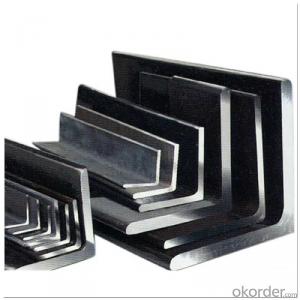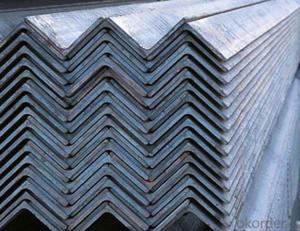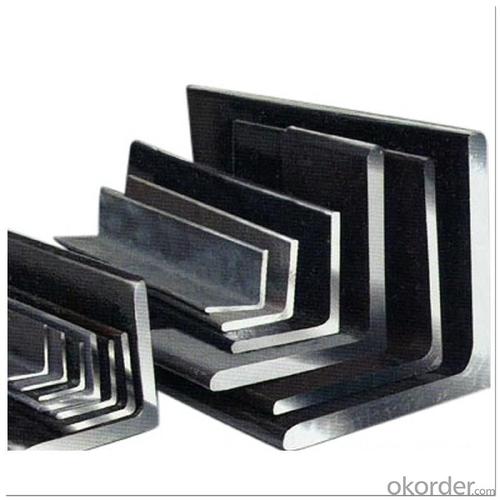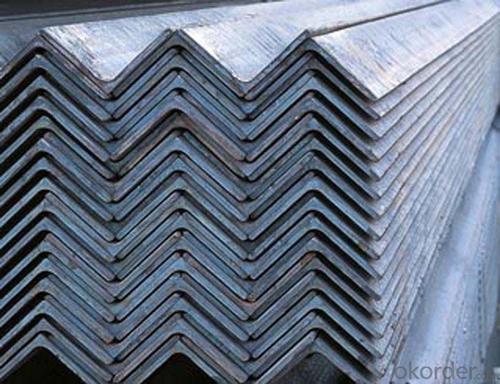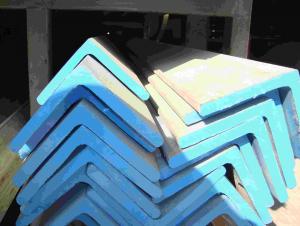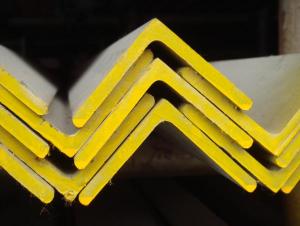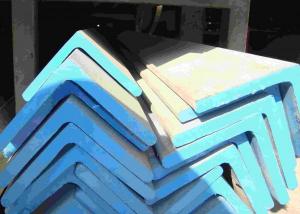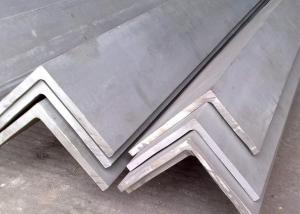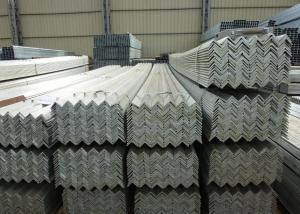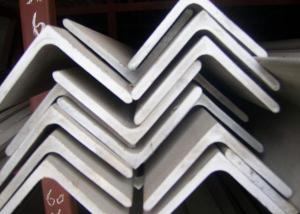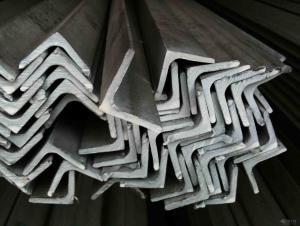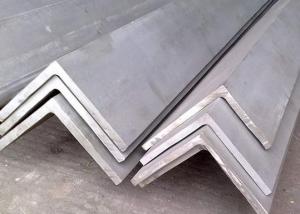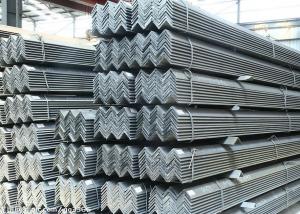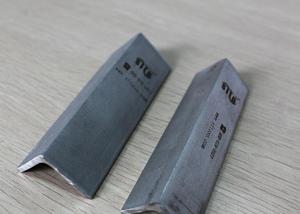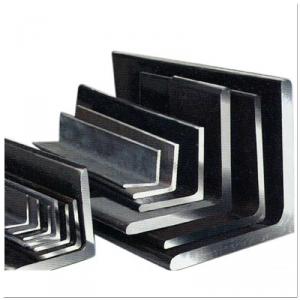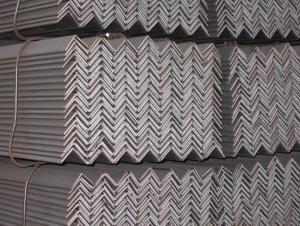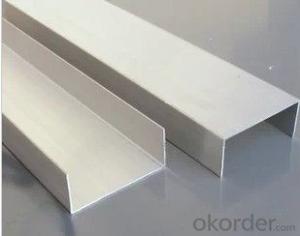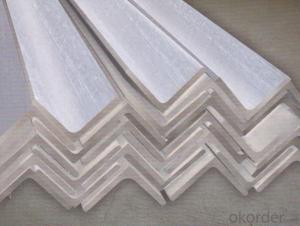stainless angles steel aisi 304 in L shaped
- Loading Port:
- Qingdao
- Payment Terms:
- TT OR LC
- Min Order Qty:
- 10 m.t.
- Supply Capability:
- 5000 m.t./month
OKorder Service Pledge
OKorder Financial Service
You Might Also Like
Products Information
Standard | AISI, ASTM, BS, DIN, GB, JIS, etc |
Grade | Q195, Q215, Q235, Q345, SS400, A36, S235JR, ST37, etc |
Technical parameters:
1) Material: Q235B , Q 345B, SS400 ,SS540, S235JR ,ETC. | |||
| 2) Usage: structure construction and electronic tower building | |||
| 3) Weight tolarance: -4% TO -10% | |||
| 4) Size tolarance : | |||
| ANGLE STEEL SIstructural steel angleE TOLARANCE (MM) | |||
| SIstructural steel angleE cm | WIDTH b/mm | THICKNESS d/mm | LENGTH /m |
| 2-5.6 | +/-0.8 | +/-0.4 | 4-12 |
| 6.3-9 | +/-1.2 | +/-0.6 | 4-12 |
| 10-14 | +/-1.8 | +/-0.7 | 4-12 |
| 16-20 | +/-2.5 | +/-1.0 | 4-12 |
| 5) Payment terms: TT or LC | |||
| 6) Delivery date: within 30 days after receiving the LC or TT prepay | |||
| 7) Packing: Export package | |||
| 8) Inspection: accept third party inspection | |||
Added information
| ||
Standard | ASTM A276, A484, A479, A580, A582, JIS G4303, JIS G4311, DIN 1654-5,DIN 17440,GB/T 1220 | |
Material | 200,300,400series, 201,202,301,304,304L,309S,310S,316,316L,316Ti,317,317L,321,347H,410,420,430,etc | |
Type | Round,square,hexagonal,flat,angle | |
Surface | Pickled,Black,Bright,Polishing,Blasting,etc | |
Specifications | Round bar | Diameter: 3mm~800mm |
Angle bar | Size: 3mm*20mm*20mm~12mm*100mm*100mm | |
Square bar | Size: 4mm*4mm~100mm*100mm | |
Flat bar | Thickness: 2mm~100mm | |
Width: 10mm~500mm | ||
Hexagonal | Size: 2mm~100mm | |
Length | 6m,5.8m,12m or as required | |
Price Term | FOB, CFR, CIF,CNF | |
Payment Term | T/T,L/C, | |
Minimum order quantity | 10 Ton | |
Package | Bundled,wooden box for export standard package. Export standard package, bundled or be required. The inner size of container is below: 20ft GP: 5.9m(length) x 2.13m(width) x 2.18m(high) about 24-26CBM 40ft GP: 11.8m(length) x 2.13m(width) x 2.18m(high) about 54CBM 40ft HG: 11.8m(length) x 2.13m(width) x 2.72m(high) about 68CBM | |
Delivery Time | Normally according to the order quantity | |
Application | Stainless steel bar applies to petroleum, chemical industry,electric power, boiler, high temperature resistant, low temperature resistant, corrosion resistant seamless steel pipe used. Stainless steel bar Stainless can be made according to the customers requirements. Fasten delivery. Quality assured. | |
- Q: What are the standard lengths for stainless steel angle?
- The standard lengths for stainless steel angle vary, but common lengths include 10 feet, 12 feet, and 20 feet.
- Q: Can stainless steel angles be used for elevator interiors?
- Yes, stainless steel angles can be used for elevator interiors. Stainless steel is a durable and corrosion-resistant material, making it suitable for high-traffic areas like elevator interiors. Additionally, its sleek and modern appearance enhances the aesthetic appeal of the elevator.
- Q: How do you calculate the deflection of a stainless steel angle?
- To calculate the deflection of a stainless steel angle, you need to utilize the principles of structural engineering and apply relevant formulas such as Euler's formula or the equation for beam deflection. These formulas take into account factors such as the material properties of stainless steel, the dimensions of the angle, and the loading conditions. By inputting these variables into the appropriate equations, you can determine the deflection of a stainless steel angle.
- Q: Are stainless steel angles resistant to sulfuric acid?
- Yes, stainless steel angles are generally resistant to sulfuric acid. Stainless steel is known for its excellent corrosion resistance, and this includes resistance to sulfuric acid. However, the level of resistance may vary depending on the grade of stainless steel used. Grades such as 304 and 316 are commonly used in applications involving sulfuric acid due to their higher resistance to corrosion. It is important to note that while stainless steel angles may be resistant to sulfuric acid, the concentration, temperature, and duration of exposure can still affect their performance. Therefore, it is always advisable to consult with a materials engineer or specialist to determine the most suitable grade of stainless steel for specific sulfuric acid applications.
- Q: What are the different types of edge finishes for stainless steel angles?
- There are several different types of edge finishes for stainless steel angles, including square, rounded, beveled, chamfered, and polished edges. Each finish provides a distinct look and can be chosen based on the desired aesthetic and functional requirements of the stainless steel angle.
- Q: How do you calculate the bending stress of a stainless steel angle?
- To calculate the bending stress of a stainless steel angle, you need to consider the moment of inertia, the distance from the neutral axis, and the applied bending moment. By using the formula for bending stress, which is stress = (M * y) / I, where M represents the bending moment, y is the distance from the neutral axis to the outermost fiber, and I is the moment of inertia, you can determine the bending stress on the stainless steel angle.
- Q: Can stainless steel angles be used in the production of power transmission equipment?
- Yes, stainless steel angles can be used in the production of power transmission equipment. Stainless steel is known for its high strength, corrosion resistance, and durability, making it a suitable material for various industrial applications, including power transmission equipment. Stainless steel angles can provide structural support, enhance stability, and withstand the demanding operating conditions of power transmission systems.
- Q: How do stainless steel angles contribute to the overall versatility of a structure?
- Stainless steel angles play a vital role in enhancing a structure's overall versatility in multiple ways. Firstly, they provide crucial support and stability to various components of a building or structure. Commonly used to reinforce corners, edges, and joints, stainless steel angles ensure the structure's stability and durability. Secondly, stainless steel angles offer flexibility in design and construction. Thanks to their unique L-shaped profile, they can be easily customized to fit any specific requirement and architectural design. This allows architects and engineers to create intricate and complex structures effortlessly while maintaining structural integrity. Furthermore, stainless steel angles are highly resistant to corrosion, making them ideal for both indoor and outdoor use. Their resistance to harsh weather conditions, chemicals, and other environmental factors ensures the longevity and durability of the structure. Moreover, stainless steel angles are fire-resistant, making them a safe choice for structural applications. In case of a fire, they can maintain their structural integrity and prevent the spread of flames, ensuring the safety of occupants and minimizing damage to the structure. Additionally, stainless steel angles require minimal upkeep and are easy to clean, making them low-maintenance materials. This reduces the overall maintenance costs of a structure, making them a cost-effective choice for long-term usage. Lastly, stainless steel angles offer aesthetic appeal to structures, adding a touch of sophistication to any design. Their sleek and modern appearance can be polished, brushed, or finished in various ways to complement the overall aesthetic of the structure. In conclusion, stainless steel angles significantly contribute to a structure's versatility through their structural support, flexibility in design, resistance to corrosion and fire, low-maintenance nature, and aesthetic appeal. Including them in construction projects ensures the strength, durability, and longevity of the structure while providing a wide range of design possibilities.
- Q: Are stainless steel angles resistant to saltwater?
- Yes, stainless steel angles are highly resistant to saltwater due to their corrosion-resistant properties.
- Q: How do you calculate the section modulus for a slotted stainless steel angle?
- To calculate the section modulus for a slotted stainless steel angle, you would need to first determine the moment of inertia of the section. The moment of inertia is a measure of an object's resistance to changes in its rotation, and it can be calculated using the dimensions and shape of the object. For a slotted stainless steel angle, you would need to know the dimensions of the angle, including the length of each leg and the thickness of the angle. Once you have these dimensions, you can use the appropriate formula to calculate the moment of inertia for the section. The moment of inertia is calculated differently depending on the shape of the section. For a slotted angle, the moment of inertia can be calculated as the sum of the individual moment of inertia for each part of the section. This means that you would need to calculate the moment of inertia for each leg of the angle and the slot separately, and then add them together. Once you have calculated the moment of inertia for the slotted stainless steel angle, you can use this value to calculate the section modulus. The section modulus is a measure of the resistance of a section to bending and is calculated by dividing the moment of inertia by the distance from the neutral axis to the outermost fiber of the section. The section modulus is an important parameter in structural engineering as it helps determine the strength and stiffness of a section. It is often used in the design of beams and other structural members to ensure that they can withstand the loads they will be subjected to. In summary, to calculate the section modulus for a slotted stainless steel angle, you would need to calculate the moment of inertia for each part of the section, including the legs and the slot, and then sum them together. This moment of inertia can then be used to calculate the section modulus, which is an important parameter in structural engineering.
Send your message to us
stainless angles steel aisi 304 in L shaped
- Loading Port:
- Qingdao
- Payment Terms:
- TT OR LC
- Min Order Qty:
- 10 m.t.
- Supply Capability:
- 5000 m.t./month
OKorder Service Pledge
OKorder Financial Service
Similar products
Hot products
Hot Searches
Related keywords
